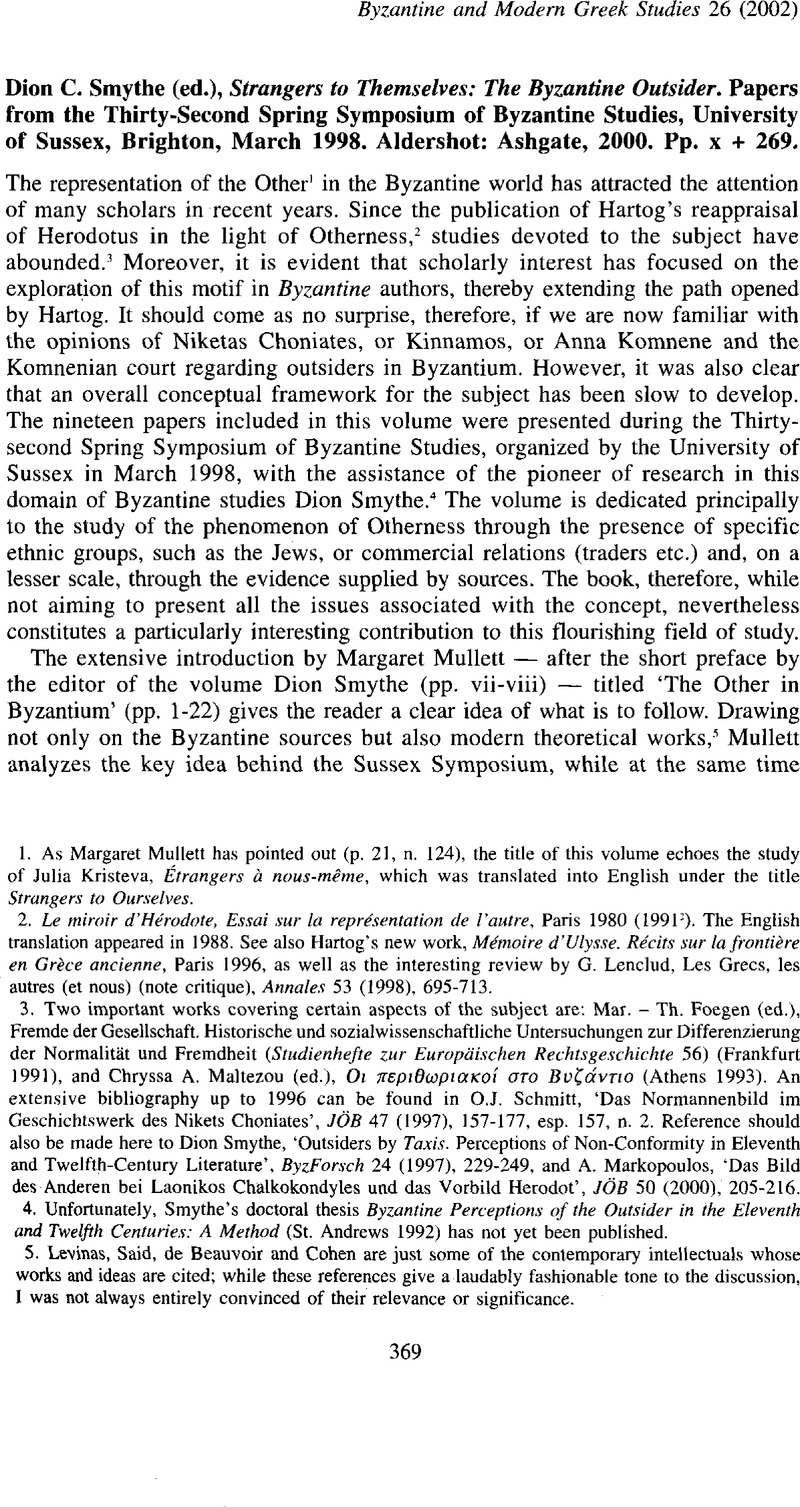No CrossRef data available.
Published online by Cambridge University Press: 22 January 2016

1. As Margaret Mullett has pointed out (p. 21, n. 124), the title of this volume echoes the study of Julia Kristeva, Étrangers à nous-même, which was translated into English under the title Strangers to Ourselves.
2. Le miroir d’Hérodote, Essai sur la représentation de Vautre, Paris 1980 (1991). The English translation appeared in 1988. See also Hartog’s new work, Mémoire d’Ulysse. Récits sur la frontière en Grèce ancienne, Paris 1996, as well as the interesting review by Lencliid, G., Les Grecs, les autres (et nous) (note critique). Annales 53 (1998), 695–713 CrossRefGoogle Scholar.
3. Two important works covering certain aspects of the subject are: Mar. - Foegen, Th. (ed.), Fremde der Gesellschaft. Historische und sozial wissenschaftliche Untersuchungen zur Differenzierung der Normalität und Fremdheit (Studienhefte zur Europäischen Rechtsgeschichte 56) (Frankfurt 1991)Google Scholar, and Maltezou, Chryssa A. (ed.), #Oi περιθωριακοί στο Βνζάντιο (Athens 1993)Google Scholar. An extensive bibliography up to 1996 can be found in Schmitt, O.J., ‘Das Normannenbild im Geschichtswerk des Nikets Choniates’, JOB 47 (1997), 157–177 Google Scholar, esp. 157, n. 2. Reference should also be made here to Smythe, Dion, ‘Outsiders by Taxis. Perceptions of Non-Conformity in Eleventh and Twelfth-Century Literature’, ByzForsch 24 (1997), 229–249 Google Scholar, and Markopoulos, A., ‘Das Bild des Anderen bei Laonikos Chalkokondyles und das Vorbild Herodot’, JOB 50 (2000), 205–216 Google Scholar.
4. Unfortunately, Smythe’s doctoral thesis Byzantine Perceptions of the Outsider in the Eleventh and Twelfth Centuries: A Method (St. Andrews 1992) has not yet been published.
5. Lévinas, Said, de Beauvoir and Cohen are just some of the contemporary intellectuals whose works and ideas are cited; while these references give a laudably fashionable tone to the discussion, I was not always entirely convinced of their relevance or significance.
6. On this subject, see in particular Smythe, Dion C., ‘Women as Outsiders’, in Liz James (ed.), Women, Men and Eunuchs. Gender in Byzantium (London and New York 1997), 149–167 Google Scholar.
7. John McGuckin, Aliens and Citizens of Elsewhere: Xeniteia in East Christian Monastic Literature, 23-28.
8. Janet Rutherford, Byzantine Ascetism — a Stranger to the Church? 39-45.
9. Jane Baun, Middle Byzantine ‘Tours of Hell’: Outsider Theodicy? 47-60.
10. Robert H. Jordan, John of Phoberou: a Voice crying in the Wilderness, 61-73.
11. A highly useful contribution to this subject is Greatrex’s article ‘The Nika Riot: a Reappraisal’, JHS 117 (1997), 60-86.
12. Foreigners in tenth-century Byzantium: a contribution to the history of cultural encounter, 229-244.
13. Byzantine conceptions of Otherness after the Annexation of Bulgaria (1018), 245-257.
14. I should note that printing errors are rare: anguage (p. ix), oustider (p. 131 sq.), though more common in the case of Greek words:ερχομενοΐ (p. 132) Πήουσίοι (p. 143, n. 67), χώραι (pp. 150, 162), Ay. Avctpyúpoi (p. 168, n. 20), θεττάηιας (p. 169, n. 22), μνεμεια μεγάηες Πρέσποκ (p. 171, n. 26).